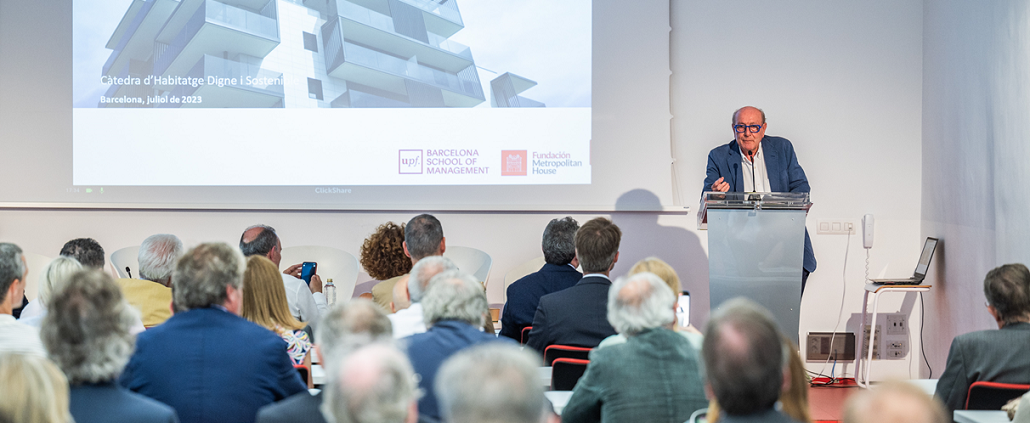The Multipartner-to-Rent financing model: a new opportunity for small and medium investors
The Multipartner-to-Rent model is an effective way to tackle the issue of affordable rental housing. This is the conclusion of the report (report link) presented by the UPF-BSM’s Chair in Decent and Sustainable Housing, in collaboration with the Metropolitan House Foundation on Wednesday July 5.
According to the barometer of the Sociological Research Center (CIS), housing is one of the main concerns of the Spanish population. The residential market is facing a tricky situation right now as it is becoming increasingly harder for a significant proportion of the population to access affordable housing.
The goals of the Multipartner-to-Rent model are to boost the growth of the supply of the affordable rental housing, promote public-private collaboration in new developments of affordable rental housing, prevent property speculation problems, channel the savings of small owners through an investment with a stable and lasting return, and for the income generated to be used to top up the owners’ future pensions.
The report explores insights into the perception of the Multipartner-to-Rent of different stakeholders, identifying the main strengths and potential areas for improvement, and analysing the effects of applying this model in the rental property market..
The Multipartner-to-Rent (MtR) model, a tool that responds to a social need
The report “Multipartner-to-Rent: new financing model for rental housing” (Access to Spanish version) were presented by the authors of the report: Ramon Bastida, the Director of the UPF-BSM’s Chair in Decent and Sustainable Housing, and Josep Lluís Pellicer, the Secretary of the Metropolitan House Foundation. They welcomed José Manuel Martínez-Sierra, the Director General of the UPF-BSM to the event, along with Rafael Angulo, the President of the Metropolitan House Foundation..

Josep Lluís Pellicer summarized the MtR model as a combination of the “horizontal ownership” of new real estate properties intended exclusively for rent, with the “vertical management of the property”.

Pellicer explained how the MtR model works step by step in order to unravel its apparent operational complexity, with a breakdown of the five phases of the project.:
- Firstly, “a group of investors set up a joint ownership association (JOA)”: it should be noted that, at this point, each investor is nominally assigned the future residential property that will be exclusively their property when the JOA is dissolved .
- The JOA then incorporates a sole proprietor holding company to execute the real estate project. The company takes ownership and buys the land, then commissions a construction company to oversee building the development on a turnkey basis, as well as bank financing, through a joint mortgage split between the investors, if required.
- Once the building is completed and signed off by the company, it registers the property and its horizontal division. The company is then liquidated and the entire building reverts to the ownership of the JOA.
- It is at this point that the JOA contracts a specialist real estate management firm that will exclusively take charge of managing all aspects of the property (letting the residential properties and overseeing the maintenance of the building). This means that all the investors “jointly” share the revenues and risks of the “entire building” and not only those related to the residential property that they were nominally assigned when they set up the JOA.
- Lastly, on then date specified in the articles of incorporation of the JOA , the JOA is dissolved, with each investor taking effective ownership of the residential property assigned to them in the JOA contract, as well as the outstanding mortgage debt on it, if any.
The general models offers a wide range of alternative possibilities derived from this basic structure, depending on the type of property, investors and renters. However, they all constitute an accessible real estate product aligned with the region and its needs.
The report shows that the MtR model is an effective tool for tackling the social need for affordable rental housing. Based on this model, it is possible to achieve the expansion of the supply of affordable rental properties while preventing speculation in an asset for the common good. Moreover, through the professionalization of the management of the rental market, the model gives investors a stable and lasting return at a very low risk which, if necessary, could be used to top up the dismal pensions that they expect in the future.
However, there is still a lot of work to do and room for improvement with respect to the model, including its legal complexity, the standardization of the model and the definition of the investor profile.
The MtR model, under discussion
After the presentation of the conclusions, a panel of experts and key figures in the housing sector debated the issues, with the participation of Carles Sala Roca, the former Minister of Housing and Urban Affairs of the Catalan Government; Agustí Solé Guardia, the Commercial Director of the Bankinter branch network; Alfons Vila Recolons, a leading businessman; and Jaume Angulo Puerta, the CEO of Metropolitan House BCN Residential. The panel was introduced and chaired by Luz Parrondo, the Director of the UPF-BSM’s Department of Finance and Control.

Carles Sala Roca welcomes the emergence of the MtR model as “an option that diversifies and breaks the dichotomy of access to housing or investing in a property as we currently know it”.
Along the same lines, Alfons Vila Recolons described the model as “an innovative way for small and medium investors to access long-term investment opportunities, through affordable rental properties”.
In the discussion, the experts agreed that one area of the MtR model with room for improvement is the legal uncertainty that comes from its complexity. Jaume Angulo Puerta, emphasized that “the Administration must get involved and establish the required regulations”, explaining that the uncertainty comes from the fact that the model is a such a new concept, as it is “the first time that several investors can join together to own a property”. He added that “more than uncertainty, there are just doubts about exactly how the model will work”.
The Decent and Sustainable Housing Chair, an engine for the future of housing
The purpose of the Decent and Sustainable Housing Chair, promoted by the UPF Barcelona School of Management in collaboration of the Metropolitan House Foundation, is to be a space for reflection aimed at analysing housing policies from a social and environmental perspective, without losing sight of the financial and economic sphere.
His studies have the objective of adapting the real estate sector to current times, with regulations that are transformed into benefits for citizens and companies, and later transferring his reflections to the main interest groups.
- More information about Decent and Sustainable Housing Chair.
- Consult the studies of the Chair




